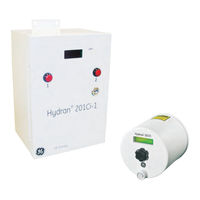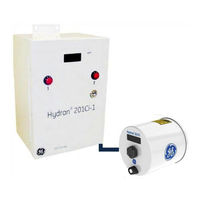GE Hydran 201i Transformer Gas Monitoring Manuals
Manuals and User Guides for GE Hydran 201i Transformer Gas Monitoring. We have 3 GE Hydran 201i Transformer Gas Monitoring manuals available for free PDF download: Instruction Manual, Installation Manual
GE Hydran 201i Instruction Manual (300 pages)
Brand: GE
|
Category: Microphone
|
Size: 2.55 MB
Table of Contents
-
-
Introduction27
-
Accessories34
-
Features37
-
Enclosure38
-
CPU Module43
-
I/O Module43
-
Battery51
-
Features57
-
Features63
-
Passwords81
-
Gas Level88
-
Gas Submenu88
-
Hourly Trend88
-
Daily Trend89
-
Battery92
-
Servicedata92
-
Baudrate94
-
Commmode94
-
Gas H Relay95
-
Analogout96
-
Gas HH Relay96
-
Sysok Relay96
-
TDM out97
-
Warnings107
-
Cabling112
-
Installation113
-
Shipping List116
-
Inspecting117
-
Preparation120
-
Gas High Alarm123
-
Fail Alarm124
-
Conclusion126
-
Installation131
-
Conclusion134
-
Sensor146
-
Commissioning150
-
Inspecting151
-
Preparation152
-
Storage152
-
Installation156
-
Conclusion160
-
Inspecting161
-
Preparation163
-
Gas High Alarm166
-
Conclusion169
-
Installation171
-
TDM Pulse178
-
Alarm Levels192
-
Alarm Relays194
-
Latch Mode196
-
Normal Mode196
-
Alarm Interface197
-
Force off197
-
Force on197
-
Gas Level199
-
Daily Trend200
-
Hourly Trend200
-
Fail Alarm204
-
Method Drawbacks210
-
Method Drawbacks211
-
Conclusion212
-
Data Reading213
-
Method Benefits213
-
Data Analysis214
-
Troubleshooting217
-
Battery L218
-
Battery LL218
-
Cableopen218
-
Cableshort220
-
Daytrend H220
-
Daytrend HH221
-
Daytrend L221
-
Daytrend LL222
-
12.1.10 Gas HH223
-
12.1.11 Gas L223
-
Gas H223
-
12.1.12 Gas LL224
-
Alarms233
-
Maintenance237
-
Fuse243
-
Advertisement
GE Hydran 201i Instruction Manual (266 pages)
Transformer Gas Monitoring System
Brand: GE
|
Category: Measuring Instruments
|
Size: 3.86 MB
Table of Contents
-
-
Accessories25
-
-
-
Passwords63
-
-
-
Preparation98
-
-
Installation106
-
-
-
Sensor118
-
-
Conclusion120
-
Commissioning121
-
-
-
Inspecting122
-
Storage123
-
Installation126
-
-
-
-
Inspecting130
-
Storage131
-
Installation138
-
Conclusion141
-
-
-
-
TDM Pulse144
-
-
-
11 Alarms
156-
Alarm Levels157
-
Alarm Relays158
-
Alarm Interface161
-
Fail Alarm167
-
-
-
Data Reading176
-
Data Analysis177
-
-
-
Battery L179
-
Battery LL179
-
Cableopen179
-
Cableshort180
-
Daytrend H181
-
Daytrend HH181
-
Daytrend L182
-
Daytrend LL182
-
Gas H183
-
Gas HH183
-
Gas L183
-
Gas LL184
-
Hourtrend H184
-
Hourtrend HH184
-
Hourtrend L185
-
Hourtrend LL185
-
Replace Sensnow185
-
Sensor Not Inst186
-
Senstemp H186
-
Senstemp HH187
-
Senstemp L187
-
Senstemp LL188
-
Setup Lost188
-
-
Alarms191
-
-
Disappeared191
-
-
-
14 Maintenance
193 -
-
Powering off200
-
GE Hydran 201i Installation Manual (37 pages)
Brand: GE
|
Category: Measuring Instruments
|
Size: 1.03 MB
Table of Contents
Advertisement
Advertisement


